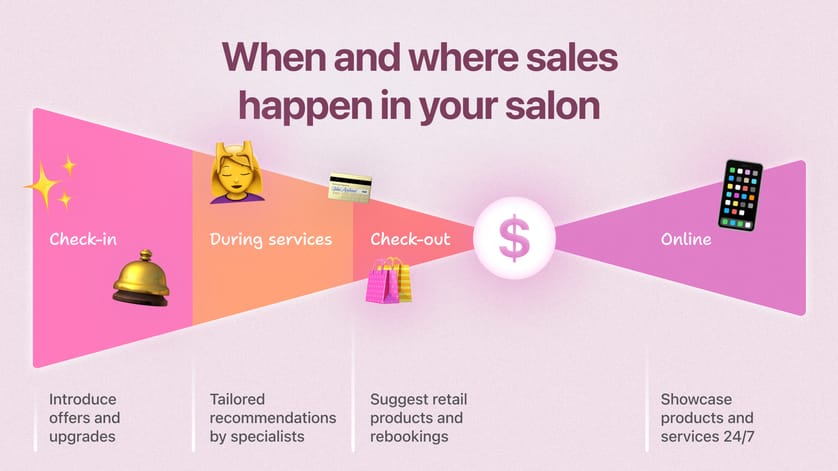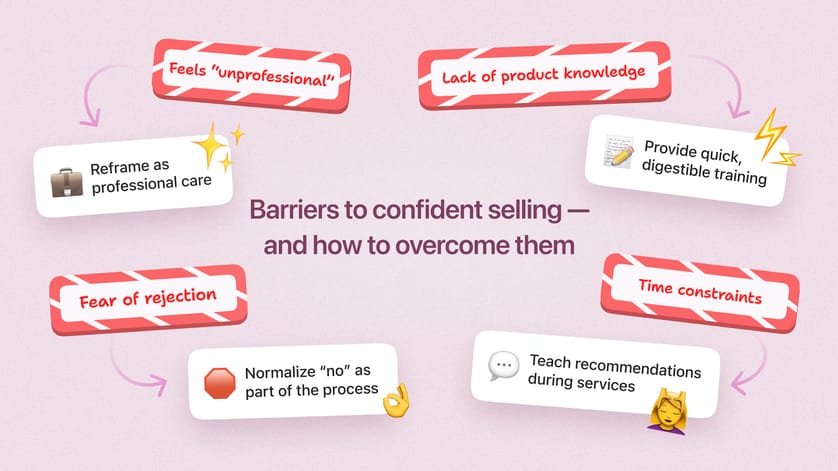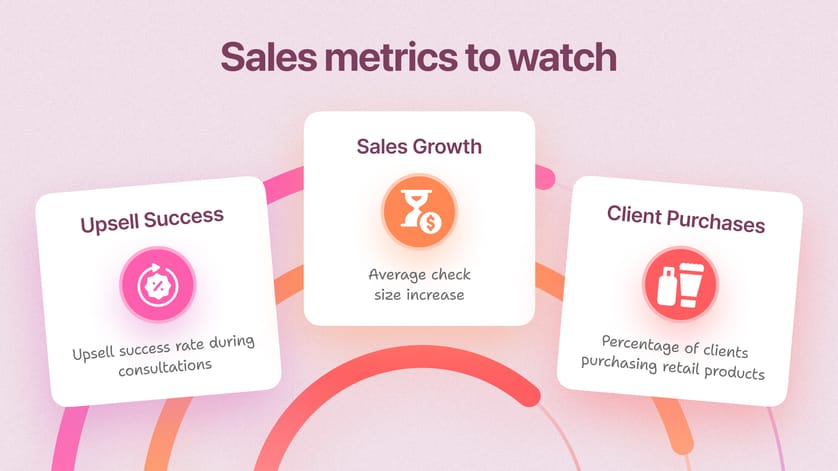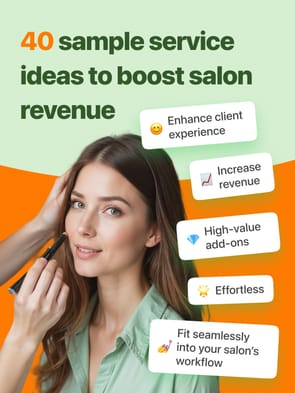Stress-free salon sales: train your team to recommend with confidence
Your salon team is packed with talent — stylists, manicurists, and receptionists who are masters at their craft. But let’s face it: selling doesn’t come naturally to everyone. And that’s okay. Selling shouldn’t feel awkward or forced — it’s about recommending products and services that genuinely improve your clients’ experience.
This article is packed with practical, human solutions to help your team feel confident in suggesting what clients need — without the hard sell. From tailored training techniques to tools that build confidence and product knowledge, we’ll guide you step-by-step to transform selling into a natural, value-driven part of your salon’s success.
Who sells in your salon — and when retail sales happen
Selling in a salon isn’t about forcing products or upselling at every turn — it’s about meeting clients’ needs naturally and effectively. To do that, you need to understand who sells, what they sell, and when they sell. This clarity is the foundation for training your team in a way that fits their strengths and roles.
The key players: receptionists and beauty professionals
Every interaction in your salon offers a sales opportunity, but how these opportunities arise depends on the team member. Let’s explore the two main players in your sales ecosystem.
| Aspect | Receptionist | Beauty specialist |
|---|---|---|
Client interaction | Brief and transactional. | Extended and relationship-based. |
Focus | General promotions and follow-ups. | Personalized, needs-based recommendations. |
Sales style | Concise and promotional. | Consultative and educational. |
Timing | During check-in or check-out. | During the service or consultation. |
Knowledge depth | General knowledge of products and services. | Deep, technical knowledge of products and treatments. |
Target products/services | Entry-level or universal products/services. | Premium, customized products/services. |
What this looks like in action
Receptionists: think of your receptionist as the friendly face that bookends a client’s visit. Their sales moments are short and strategic:
- Check-in: mentioning current promotions or add-ons while confirming appointments.
- Phone Calls: suggesting upgrades or bundles when clients book services.
- Check-out: recommending retail products or gift cards as they wrap up the visit.
Example: A receptionist might say, “Did you know we’re offering 15% off our smoothing serum today? It’s great for keeping your style fresh between visits.”
Beauty specialists: your stylists, manicurists, and estheticians spend the most time with clients, building trust and offering expertise. Their sales moments are woven naturally into their services:
- During the service: recommending treatments or products based on the client’s needs.
- Consultations: offering solutions to problems clients mention during their appointment.
Example: A stylist might suggest, “Your hair is a bit dry — this leave-in conditioner will keep it hydrated until your next visit.”
When and where client purchases happen
Sales in a salon don’t happen all at once — they’re spread across the client’s journey.
- Check-in: receptionists introduce offers or upgrade options.
- During Services: specialists provide tailored recommendations based on the client’s experience.
- Check-out: receptionists finalize sales by suggesting retail products or rebooking appointments.
- Online: social media platforms and your website showcase retail products, specials, and services to generate client purchases even outside their visit and help your employees sell inside.
By understanding these roles and moments, you can tailor sales strategies that work with — not against — your team’s natural strengths.
Know what your clients really want!
Boost your salon clients with our 3 essential client feedback questionnaires PDF. Discover exactly what keeps clients happy — coming back. Download now to elevate your salon’s reputation!
Oh no! We couldn’t subscribe you ☹️
Done! We've sent a link to your Email 📨
What holds your team back from sales training success?
If your salon staff struggles with selling, it’s not because they lack talent — it’s because selling feels unnatural to them. They’ve perfected their craft, whether it’s creating flawless balayage or delivering spa-like manicures, but the thought of pitching a product or service? That’s where hesitation creeps in. Before diving into sales techniques, let’s identify the barriers holding your team back.
“You don’t have to be great to start, but you have to start to be great.” Zig Ziglar
1. Selling feels “unprofessional”
Example: a stylist might think, “I’m here to create great hair, not to sell shampoo.” This mindset comes from a belief that selling takes away from their role as a beauty professional. They want to be seen as an artist or expert, not a salesperson.
The solution: reframe selling as recommending. Instead of “pushing” products, show them how suggesting a leave-in conditioner protects their client’s investment in a fresh color. Selling becomes part of their professional care — not an afterthought.
2. Lack of confidence in product knowledge
Example: your receptionist might avoid mentioning a hair serum at checkout because they’re not sure how it works or who it’s for. Without proper knowledge, even the most enthusiastic team member won’t feel confident recommending retail products.
The solution: provide quick, digestible product training sessions during team meetings. Focus on benefits, use cases, and simple scripts they can use. For example: “This serum is perfect for keeping frizz under control on humid days.”
3. Fear of rejection
Example: a manicurist might think, “what if they say no? i’ll feel so awkward!” fear of rejection is common. No one wants to hear “no,” especially in a client-focused environment where relationships are key.
The solution: normalize rejection as part of the process. Share stories about successful salespeople who heard “no” more often than “yes” but still achieved incredible results. Create a supportive environment where rejection isn’t a failure but a step closer to success.
4. Time constraints
Example: a busy stylist might think, “I barely have time to finish this appointment — how am I supposed to sell too?” When appointments are packed, sales can feel like an extra task rather than a natural part of the service.
The solution: teach staff to integrate recommendations into their workflow. For example, while washing a client’s hair, a stylist might say, “This shampoo is great for keeping your color vibrant — do you want me to grab one for you before you leave?”
Knowledge is power, but applied knowledge is a game changer.
5. Misalignment with personal identity
Example: a beauty professional might think, “I didn’t become a stylist to sell products — I’m here to help people feel amazing.” For some, selling feels like it conflicts with their purpose as a creative or caretaker.
The solution: help them see selling as an extension of their role. By recommending the right products or services, they’re helping clients feel amazing beyond the salon. Reinforce that this isn’t about quotas; it’s about enhancing the client’s experience.
6. Inadequate incentives
Example: a receptionist might think, “Why should I put in the extra effort if I don’t see any reward?” Without meaningful incentives, there’s little motivation to go above and beyond in recommending products or services.
The solution: introduce rewards that align with their effort, like small bonuses for hitting sales goals or recognition in team meetings. Keep the focus on client satisfaction and professional growth, not just numbers.
7. Client perception concerns
Example: a stylist might think, “I don’t want my client to feel like I’m just trying to make money off them.” Staff may worry that clients will view them as pushy or insincere if they start recommending products or services.
The solution: teach subtle, consultative sales techniques. Instead of directly pitching, frame recommendations around solving a client’s problem: “Your skin’s been dry lately — this moisturizer would really help between facials.”
Understanding these barriers helps you tailor your training to address specific concerns. By showing your team how to sell in a way that feels authentic, you’ll unlock their confidence and motivation. In the next section, we’ll explore actionable sales techniques to help your team turn these challenges into strengths.
Bringing it all together
Here’s the thing: not every stylist, manicurist, or receptionist hesitates to sell for the same reason. Maybe your receptionist feels like recommending products isn’t their job. Maybe your stylist worries about sounding like a shampoo infomercial. Or maybe your manicurist just hates the thought of hearing “no.” Whatever the case, your first step is to figure out why they’re holding back.
Start by playing detective. Identify the main barriers in your salon — is it a lack of confidence? Not enough product knowledge? Fear of rejection? Once you know what’s stopping your team, you can match the right sales techniques to the right people:
- Your receptionist needs simple scripts and tools to make quick, confident recommendations.
- Your stylist might benefit from learning how to integrate subtle suggestions into their consultations.
- And your manicurist? Teach them that a “no” isn’t personal — it’s just one step closer to a “yes.”
The key is tailoring the training to fit their roles and strengths. The good news? We’ve got all the details you need to make it happen. In the next section, we’ll break down specific training methods, tools, and tips to transform your team into confident, value-driven sellers.
Fun and practical salon retail sales training techniques
Training your salon team doesn’t have to feel like a corporate seminar or a chore. In fact, the more engaging and tailored your approach, the faster your beauty professionals will pick up these skills. Let’s break it down into fun, effective ways to teach sales techniques and turn your team into confident recommenders.
Role-playing: the safe space to practice
Nobody becomes a master without practice — and role-playing gives your team a judgment-free zone to hone their skills.
How it works: create scenarios based on real client interactions. Start simple:
- “A client with dry hair asks for advice.”
- “A customer hesitates about booking a deep-conditioning treatment.” Gradually increase the difficulty to include objections like, “I’m not sure if it’s worth the cost.”
Why it works: practicing tough conversations builds confidence and muscle memory, so the real thing feels effortless.
Make it fun: throw in a wildcard like, “The client is in a rush — recommend something in 15 seconds!”
Quick product knowledge sessions
No one can sell what they don’t understand. Give your team the tools to confidently recommend retail products and services.
How it works: dedicate 10 minutes at the start of each day or week to focus on one product. Explain:
- What it does.
- Who it’s for.
- A quick, memorable pitch (e.g., “This serum is like SPF for your hair — keeps it shiny and protected!”).
Pro tip: provide cheat sheets they can refer to throughout the day.
Shadowing the pros
Watching someone else nail a sale can be just as valuable as doing it yourself.
How it works: pair less confident team members with those who are already great at recommending products. Let them observe how recommendations flow naturally during consultations or checkouts.
Follow-up: after the observation, ask, “What did you notice? How did they make the client comfortable?” Discuss takeaways and how they can apply them.
Gamify the process of salon sales training
Sales training doesn’t have to be all serious — turn it into a game!
How it works:
- Create mini-challenges like:
- “Recommend one product to each client today.”
- “Upsell a treatment during consultations.”
- Reward wins with small prizes or shout-outs at team meetings.
Why It works: a little competition adds excitement and keeps the team engaged.
Use video feedback (yes, really!)
It might sound daunting, but watching themselves in action can help your team improve faster.
How it works: record mock sales interactions and play them back. Focus on:
- Tone of voice.
- Body language.
- How they respond to client objections.
Why it works: seeing themselves succeed builds confidence, while spotting small improvements makes a big difference.
Integrate training into daily workflow
Training doesn’t need to disrupt your team’s day — it can blend seamlessly into their routine.
- Morning huddles: start the day with a 5-minute pep talk and a quick sales tip. Example: “Today, focus on suggesting one retail product to each client.”
- Midday recaps: take 2-3 minutes to check in with each team member. Ask what’s working and where they need support.
- End-of-day wins: celebrate successes, big or small. Even a simple, “You did great recommending that serum!” goes a long way.
Encourage fun, low-stakes selling
Sometimes the best practice comes from selling something unrelated to the salon.
How it works: have team members practice selling random items (like a pen or a coffee mug) to each other.
Why it works: it removes the pressure and teaches the art of persuasion in a fun way.
Bring in the experts
If you feel like your team needs a little extra help, bring in a sales coach who specializes in the beauty industry.
Why it’s worth it: a fresh perspective from a pro can teach advanced techniques, answer tough questions, and re-energize your team.
With these techniques in your toolkit, training doesn’t have to feel like “work.” It’s about building confidence, creating opportunities for growth, and making selling a natural part of what your team does best. Next, we’ll dive into how to track progress and keep motivation high as your team becomes a sales powerhouse.
Track progress and keep motivation high
Training doesn’t end with the first successful upsell. For your team’s new skills to stick, you need a system to track progress, encourage growth, and keep the energy alive. Think of it like maintaining a great hairstyle—it takes consistent care and attention to keep things looking sharp.
Set clear goals, but make them meaningful
“Sell 10 products a week” might be measurable, but it won’t inspire. Instead, tie goals to their impact.
Example: “Let’s focus on recommending treatments that help clients maintain their style longer between visits.”
This reframes the goal as problem-solving, not selling. A stylist is more likely to suggest a product when they see how it directly benefits the client.
Track the right metrics without micromanaging
Use your salon’s CRM or inventory system to measure trends, but don’t bog your team down with endless reports.
Focus on outcomes that matter: Are clients buying more retail products? Are services being upgraded more frequently?
Example: “We’ve seen a 20% boost in retail sales this month—great job weaving product recommendations into consultations.”
Feedback should feel like collaboration, not criticism. Discuss results in a way that feels supportive, like brainstorming solutions together.
Celebrate success, big and small
Recognizing achievements, no matter how small, keeps morale high. Public praise goes a long way.
Example: “Alex, your client was thrilled with the hydrating mask you suggested last week—they even rebooked for another treatment. Amazing work!” This kind of feedback reinforces good habits and shows the team that their efforts matter.
Keep the training going (without the burnout)
As clients’ needs evolve, so should your team’s knowledge. Sales training shouldn’t stop after the basics.
Example: bring in a guest trainer for seasonal products, like sun protection in summer or nourishing treatments in winter. Fresh input keeps the team excited and sharp.
Add small refreshers into daily routines. Start your morning meeting with, “Who tried a new technique yesterday? What worked?” This keeps learning collaborative and continuous.
Conclusion
Sales in a salon aren’t about pushing products — they’re about showing clients you care about their needs. A stylist recommending a heat protectant isn’t just selling; they’re helping their client avoid split ends and maintain their blowout for longer.
By making progress measurable, celebrating growth, and consistently refreshing your team’s skills, you create a culture of confidence and success. Remember, every little step counts. Even if a stylist only sells one extra product a day, the cumulative impact on your salon’s revenue and client satisfaction is massive.
Your team already has the talent. Now, with the right support, they’ll have the confidence to back it up. It’s time to take the skills they’ve built and turn them into unstoppable momentum.
 The latest articles and industry insights delivered to your inbox
The latest articles and industry insights delivered to your inbox
Subscribe to receive a monthly digest of our most valuable resources like blog posts, whitepapers, and guides.
Oh no! We couldn’t subscribe you ☹️
Done! You've subscribed 💛
Unsubscribe anytime. Your data is stored for business-to-business communication purposes. See our Privacy policy.
Frequently asked questions
Why is salon sales training important for my team?
Because retail sales are the secret sauce to making more money while improving the client’s experience. A well-trained team can recommend retail products naturally, turning client purchases into long-term loyalty.
What’s the difference between retail sales and salon retail sales?
Retail sales are general, but salon retail sales are tailored specifically to your salon’s product offerings and services. It’s about finding the right product for each client’s needs, not just selling for the sake of it.
How can I motivate beauty professionals to sell?
Make it about solutions, not sales. For example, “This product protects your color longer” feels less pushy and more helpful. Pair this with tailored incentives like free products or client feedback recognition, and they’ll feel confident recommending.
How can product knowledge boost retail sales?
Without it, even the most confident team member will hesitate. Teach them what each product does, who it’s for, and why it’s amazing. A quick tip: “This serum is like SPF for your hair—protection and shine in one!”
How do I fit sales training into a busy salon schedule?
Use bite-sized sessions during valuable time you already have, like morning huddles. Share one sales technique or highlight a retail product in five minutes. Short and simple wins the day.
Do social media platforms really help with retail sales?
Absolutely! Post about your retail products in action—think “before and after” shots or product tips from your beauty professionals. It’s free marketing that attracts new clients while reminding existing ones to stop by.
How can I track the impact of sales training?
Look at client purchases, the average ticket size, and the revenue increase over time. Tools like your salon’s CRM or inventory system make it easy to measure success and adjust strategies.
What should I do if my team feels uncomfortable selling?
Start with tailored sales techniques that feel natural, like recommending products during services. Focus on how retail sales enhance the client’s experience instead of just hitting numbers.
Can online learning work for salon sales training?
Yes! Online learning saves valuable time for salon owners and staff. Use interactive modules or webinars to teach product knowledge and sales techniques without disrupting the salon business.
What’s the easiest way to increase salon retail sales?
Make selling part of your salon services. During a consultation, beauty professionals can recommend products to improve results. It’s a seamless way to add value for clients and bring in more money for the salon.
Last updated on Jan 21, 2025
“What Changed” in this article? Everything. It's packed with the latest findings, the ripest data, and a fresh analysis you won't find anywhere else.
A subject-matter expert wrote the content, and reliable, official sources support it. Recent research has been incorporated to maintain relevancy and accuracy.
Please share this post
Table of Contents
Who sells in your salon — and when retail sales happenWhat holds your team back from sales training success?Fun and practical salon retail sales training techniquesTrack progress and keep motivation highConclusionFrequently asked questionsHow to sell beauty products to clients and not sound salesy
Want to boost your beauty product sales without sounding pushy? Discover expert tips on upselling, using product expertise, and planning promotions to keep your clients coming back for more.
Salon marketing
12 min
Six clever ways to diversify your salon’s revenue streams
Running a salon isn’t just about appointments. This article gives you six smart ways to diversify your income. From selling memberships to leasing space, it’s packed with ideas to keep the cash flowing and your business future-ready (without the stress).
Salon business
8 min
Cut inventory costs in salon: save on salon inventory & optimize stock
Unlock the secrets to slashing salon inventory costs! Boost profits by 10–15% with expert strategies and game-changing techniques to optimize stock and save thousands yearly.
Inventory management in beauty business
14 min
Unlock FREE bonus material!
Get your hands on "50 sample service ideas to boost salon revenue". Subscribe to our newsletter and receive a link to download it straight to your inbox.
Oh no! We couldn’t subscribe you ☹️
Done! We've sent a link to your Email 📨
Trusted by the best in the beauty industry.
Transform your beauty business with Suplery!
Already enjoying our expert tips? Take the next step and join Suplery to revolutionize your business operations.
Huge range of professional products
One-click checkout after first order
Automated predictive orders
Seamless inventory management
From words to action
Start working with Suplery and explore all the tools and services you need to expand your business
Get started with Suplery24/7 Support
Secure payments
Designed by industry’s experts









